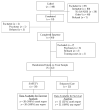Cognitive-Behavioral Family Treatment for Suicide Attempt Prevention: A Randomized Controlled Trial
- PMID: 28545756
- PMCID: PMC5474088
- DOI: 10.1016/j.jaac.2017.03.015
Cognitive-Behavioral Family Treatment for Suicide Attempt Prevention: A Randomized Controlled Trial
Abstract
Objective: Suicide is a leading cause of death. New data indicate alarming increases in suicide death rates, yet no treatments with replicated efficacy or effectiveness exist for youths with self-harm presentations, a high-risk group for both fatal and nonfatal suicide attempts. We addressed this gap by evaluating Safe Alternatives for Teens and Youths (SAFETY), a cognitive-behavioral, dialectical behavior therapy-informed family treatment designed to promote safety.
Method: Randomized controlled trial for adolescents (12-18 years of age) with recent (past 3 months) suicide attempts or other self-harm. Youth were randomized either to SAFETY or to treatment as usual enhanced by parent education and support accessing community treatment (E-TAU). Outcomes were evaluated at baseline, 3 months, or end of treatment period, and were followed up through 6 to 12 months. The primary outcome was youth-reported incident suicide attempts through the 3-month follow-up.
Results: Survival analyses indicated a significantly higher probability of survival without a suicide attempt by the 3-month follow-up point among SAFETY youths (cumulative estimated probability of survival without suicide attempt = 1.00, standard error = 0), compared to E-TAU youths (cumulative estimated probability of survival without suicide attempt = 0.67, standard error = 0.14; z = 2.45, p = .02, number needed to treat = 3) and for the overall survival curves (Wilcoxon χ21 = 5.81, p = .02). Sensitivity analyses using parent report when youth report was unavailable and conservative assumptions regarding missing data yielded similar results for 3-month outcomes.
Conclusion: Results support the efficacy of SAFETY for preventing suicide attempts in adolescents presenting with recent self-harm. This is the second randomized trial to demonstrate that treatment including cognitive-behavioral and family components can provide some protection from suicide attempt risk in these high-risk youths. Clinical trial registration information-Effectiveness of a Family-Based Intervention for Adolescent Suicide Attempters (The SAFETY Study); http://clinicaltrials.gov/; NCT00692302.
Keywords: nonsuicidal self-injuries; self-harm; suicidal attempts; treatment.
Copyright © 2017 American Academy of Child and Adolescent Psychiatry. Published by Elsevier Inc. All rights reserved.
Figures


References
-
- Curtin SC, Warner M, Hedegaard H. Increase in suicide in the United States, 1999–2014. [Accessed March 3, 2017];NCHS Data Brief. 2016 (241) http://www.cdc.gov/nchs/products/databriefs/db241.htm. http://dx.doi.org/10.15585/mmwr.mm6543a8. - DOI - PubMed
-
- Crosby AE, Ortega L, Melanson C. Self-directed Violence Surveillance: Uniform Definitions and Recommended Data Elements, Version 1.0. Atlanta: Centers for Disease Control and Prevention, National Center for Injury Prevention and Control; 2011.
-
- Wilkinson P, Kelvin R, Roberts C, Dubicka B, Goodyer I. Clinical and psychosocial predictors of suicide attempts and nonsuicidal self-injury in the Adolescent Depression Antidepressants and Psychotherapy Trial (ADAPT) Am J Psychiatry. 2011;168:495–501. - PubMed
Publication types
MeSH terms
Associated data
Grants and funding
LinkOut - more resources
Full Text Sources
Other Literature Sources
Medical
Miscellaneous

